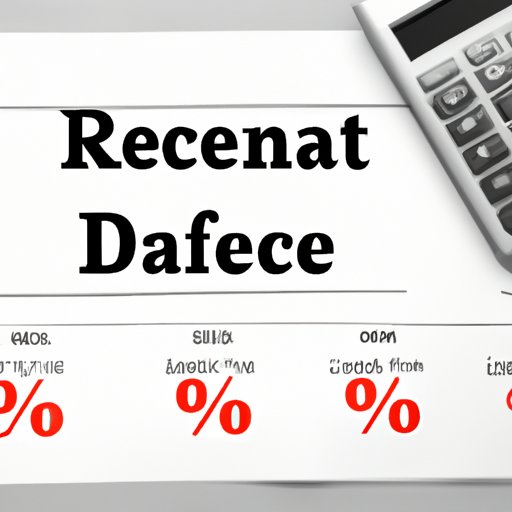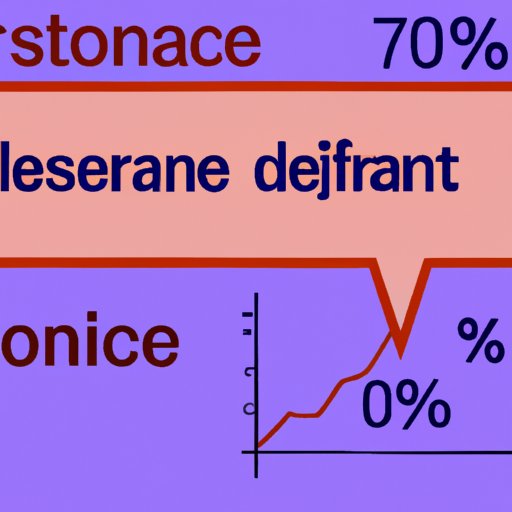Introduction
A discount rate in finance is an important tool used to measure the present or future value of money. It is typically used to determine the expected return on investments, calculate the cost of capital for businesses, or assess the value of stock options. In this article, we will explore the basics of a discount rate, how it affects financial decisions, its role in financial planning, and the benefits and risks associated with using a discount rate.

Exploring the Basics of a Discount Rate in Finance
A discount rate is a number that is used to calculate the present or future value of money. It is usually expressed as a percentage and is determined by factors such as the cost of capital, inflation, and other economic variables. The discount rate can also be adjusted to reflect the risk associated with an investment.
What is a Discount Rate?
The discount rate is the amount of interest that is charged when borrowing money or investing in a financial asset. It is used to calculate the present or future value of money. For example, if you borrow $100 at a 10% discount rate, you would have to pay back $110 at the end of the loan period. Similarly, if you invest $100 at a 10% discount rate, you would receive $110 at the end of the investment period.
Types of Discount Rates
There are several types of discount rates that may be used in financial transactions. These include the nominal discount rate, the real discount rate, the risk-free rate, and the market rate. The nominal discount rate is the rate of return that is assumed to be earned on an investment. The real discount rate is the rate of return after adjusting for inflation. The risk-free rate is the rate of return that is assumed to be earned on a risk-free investment, such as U.S. Treasury bonds. The market rate is the rate of return that is assumed to be earned on a financial asset.
How Does a Discount Rate Affect Financial Decisions?
The discount rate is an important factor in making financial decisions. It can be used to calculate the present or future value of money, which can help determine whether an investment is worth making. For example, if you are considering investing in a stock, the discount rate can help you decide whether the expected return is high enough to justify the risk.

Understanding the Role of a Discount Rate in Financial Planning
The discount rate plays a key role in financial planning. By calculating the present or future value of money, it can help investors make informed decisions about their investments. Additionally, it can help to determine the cost of capital for businesses and assess the value of stock options.
Benefits of Using a Discount Rate
Using a discount rate can provide several benefits to investors. It can help them to make more informed decisions about their investments, as well as assess the potential returns of different investments. Additionally, it can help to calculate the cost of capital for businesses, which can help them to make better decisions about their operations.
Factors to Consider When Choosing a Discount Rate
When choosing a discount rate, there are several factors to consider. These include the expected rate of return on the investment, the risk associated with the investment, and the current economic conditions. Additionally, it is important to consider the inflation rate, as this can affect the discount rate and the expected return on the investment.

Calculating the Impact of a Discount Rate in Financial Decisions
The discount rate can be used to calculate the present or future value of money. This can be done by calculating the present value (PV) or the future value (FV). The PV is the current value of an investment, while the FV is the value of the investment at some point in the future.
Calculating Present Value
The present value of an investment can be calculated using the following formula: PV = FV/(1 + r)^t, where FV is the future value of the investment, r is the discount rate, and t is the time period of the investment. For example, if you were to invest $100 at a 5% discount rate for five years, the present value would be $78.66 ($100/(1 + 0.05)^5).
Calculating Future Value
The future value of an investment can be calculated using the following formula: FV = PV*(1 + r)^t, where PV is the present value of the investment, r is the discount rate, and t is the time period of the investment. For example, if you were to invest $100 at a 5% discount rate for five years, the future value would be $128.14 ($100*(1 + 0.05)^5).
How to Use a Discount Rate in Investment Strategies
The discount rate can be used to calculate the internal rate of return (IRR) and the net present value (NPV) of an investment. The IRR is the rate of return that is expected to be earned on an investment, while the NPV is the present value of an investment minus the cost of the investment.
Calculating Internal Rate of Return (IRR)
The internal rate of return (IRR) can be calculated using the following formula: IRR = (FV/PV)^(1/t) – 1, where FV is the future value of the investment, PV is the present value of the investment, and t is the time period of the investment. For example, if you were to invest $100 at a 5% discount rate for five years, the IRR would be 8.50% ((128.14/78.66)^(1/5) – 1).
Calculating Net Present Value (NPV)
The net present value (NPV) can be calculated using the following formula: NPV = PV – Cost, where PV is the present value of the investment and Cost is the cost of the investment. For example, if you were to invest $100 at a 5% discount rate for five years, and the cost of the investment was $80, the NPV would be $18.66 (78.66 – 80).
Analyzing the Benefits and Risks of a Discount Rate in Financial Transactions
A discount rate can provide several benefits to investors, but it also comes with certain risks. It is important to understand both the benefits and risks associated with using a discount rate before making any financial decisions.
Benefits of a Discount Rate
Using a discount rate can provide several benefits to investors. It can help them to make more informed decisions about their investments, as well as assess the potential returns of different investments. Additionally, it can help to calculate the cost of capital for businesses, which can help them to make better decisions about their operations.
Risks of a Discount Rate
The primary risk associated with using a discount rate is that it is based on assumptions about future economic conditions. If these assumptions are incorrect, the discount rate could be inaccurate, resulting in unexpected losses for the investor. Another risk is that the discount rate does not take into account the risk associated with the investment, which could lead to higher losses if the investment does not perform as expected.
Conclusion
In conclusion, a discount rate in finance is an important tool used to measure the present or future value of money. It can be used to calculate the expected return on investments, calculate the cost of capital for businesses, or assess the value of stock options. Additionally, it can help investors to make more informed decisions about their investments, as well as assess the potential returns of different investments. However, it is important to understand the risks associated with using a discount rate before making any financial decisions.
(Note: Is this article not meeting your expectations? Do you have knowledge or insights to share? Unlock new opportunities and expand your reach by joining our authors team. Click Registration to join us and share your expertise with our readers.)
